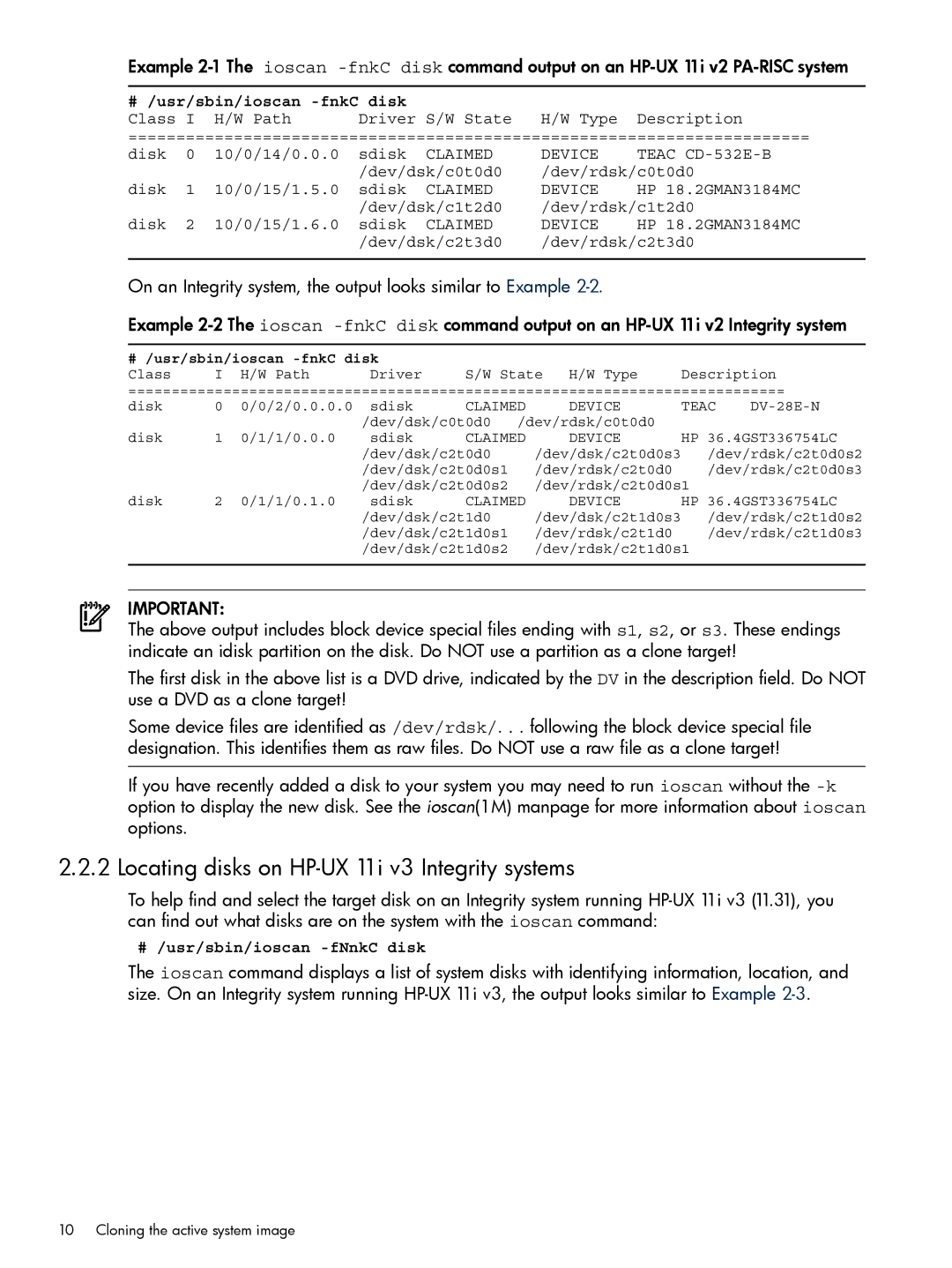
Example
# /usr/sbin/ioscan |
| |
Class I H/W Path | Driver S/W State | H/W Type Description |
=======================================================================
disk 0 | 10/0/14/0.0.0 | sdisk | CLAIMED | DEVICE | TEAC |
|
| /dev/dsk/c0t0d0 | /dev/rdsk/c0t0d0 | ||
disk 1 | 10/0/15/1.5.0 | sdisk | CLAIMED | DEVICE | HP 18.2GMAN3184MC |
|
| /dev/dsk/c1t2d0 | /dev/rdsk/c1t2d0 | ||
disk 2 | 10/0/15/1.6.0 | sdisk | CLAIMED | DEVICE | HP 18.2GMAN3184MC |
|
| /dev/dsk/c2t3d0 | /dev/rdsk/c2t3d0 | ||
On an Integrity system, the output looks similar to Example
Example
# /usr/sbin/ioscan |
|
|
|
|
| |||
Class | I | H/W Path | Driver | S/W State H/W Type | Description | |||
============================================================================ | ||||||||
disk | 0 | 0/0/2/0.0.0.0 | sdisk | CLAIMED | DEVICE | TEAC | ||
|
|
| /dev/dsk/c0t0d0 | /dev/rdsk/c0t0d0 |
|
| ||
disk | 1 | 0/1/1/0.0.0 | sdisk | CLAIMED | DEVICE | HP 36.4GST336754LC | ||
|
|
| /dev/dsk/c2t0d0 |
| /dev/dsk/c2t0d0s3 | /dev/rdsk/c2t0d0s2 | ||
|
|
| /dev/dsk/c2t0d0s1 |
| /dev/rdsk/c2t0d0 | /dev/rdsk/c2t0d0s3 | ||
|
|
| /dev/dsk/c2t0d0s2 |
| /dev/rdsk/c2t0d0s1 |
| ||
disk | 2 | 0/1/1/0.1.0 | sdisk | CLAIMED | DEVICE | HP 36.4GST336754LC | ||
|
|
| /dev/dsk/c2t1d0 |
| /dev/dsk/c2t1d0s3 | /dev/rdsk/c2t1d0s2 | ||
|
|
| /dev/dsk/c2t1d0s1 |
| /dev/rdsk/c2t1d0 | /dev/rdsk/c2t1d0s3 | ||
|
|
| /dev/dsk/c2t1d0s2 |
| /dev/rdsk/c2t1d0s1 |
| ||
IMPORTANT:
The above output includes block device special files ending with s1, s2, or s3. These endings indicate an idisk partition on the disk. Do NOT use a partition as a clone target!
The first disk in the above list is a DVD drive, indicated by the DV in the description field. Do NOT use a DVD as a clone target!
Some device files are identified as /dev/rdsk/. . . following the block device special file designation. This identifies them as raw files. Do NOT use a raw file as a clone target!
If you have recently added a disk to your system you may need to run ioscan without the
2.2.2 Locating disks on HP-UX 11i v3 Integrity systems
To help find and select the target disk on an Integrity system running
# /usr/sbin/ioscan
The ioscan command displays a list of system disks with identifying information, location, and size. On an Integrity system running
10 Cloning the active system image
